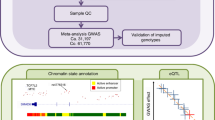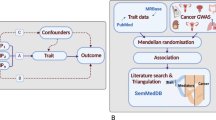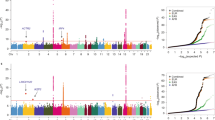Abstract
We have conducted a pathway-based analysis of genome-wide single-nucleotide polymorphism (SNP) data in order to identify genetic susceptibility factors for cervical cancer in situ. Genotypes derived from Affymetrix 500k or 5.0 arrays for 1076 cases and 1426 controls were analyzed for association, and pathways with enriched signals were identified using the SNP ratio test. The most strongly associated KEGG (Kyoto Encyclopedia of Genes and Genomes) pathways were Asthma (empirical P=0.03), Folate biosynthesis (empirical P=0.04) and Graft-versus-host disease (empirical P=0.05). Among the 11 top-ranking pathways were 6 related to the immune response with the common denominator being genes in the major histocompatibility complex (MHC) region on chromosome 6. Further investigation of the MHC revealed a clear effect of HLA-DPB1 polymorphism on disease susceptibility. At a functional level, DPB1 alleles associated with risk and protection differ in key amino-acid residues affecting peptide-binding motifs in the extracellular domains. The results illustrate the value of pathway-based analysis to mine genome-wide data, and point to the importance of the MHC region and specifically the HLA-DPB1 locus for susceptibility to cervical cancer.
This is a preview of subscription content, access via your institution
Access options
Subscribe to this journal
Receive 6 digital issues and online access to articles
$119.00 per year
only $19.83 per issue
Buy this article
- Purchase on Springer Link
- Instant access to full article PDF
Prices may be subject to local taxes which are calculated during checkout



Similar content being viewed by others
References
Parkin DM, Bray F, Ferlay J, Pisani P . Global cancer statistics, 2002. CA Cancer J Clin 2005; 55: 74–108.
Walboomers JM, Jacobs MV, Manos MM, Bosch FX, Kummer JA, Shah KV et al. Human papillomavirus is a necessary cause of invasive cervical cancer worldwide. J Pathol 1999; 189: 12–19.
Baseman JG, Koutsky LA . The epidemiology of human papillomavirus infections. J Clin Virol 2005; 32 (Suppl 1): S16–S24.
Magnusson PK, Sparen P, Gyllensten UB . Genetic link to cervical tumours. Nature 1999; 400: 29–30.
Magnusson PK, Lichtenstein P, Gyllensten UB . Heritability of cervical tumours. Int J Cancer 2000; 88: 698–701.
Apple RJ, Erlich HA, Klitz W, Manos MM, Becker TM, Wheeler CM . HLA DR-DQ associations with cervical carcinoma show papillomavirus-type specificity. Nat Genet 1994; 6: 157–162.
Beskow AH, Josefsson AM, Gyllensten UB . HLA class II alleles associated with infection by HPV16 in cervical cancer in situ. Int J Cancer 2001; 93: 817–822.
Wang SS, Hildesheim A . Chapter 5: viral and host factors in human papillomavirus persistence and progression. J Natl Cancer Inst Monogr 2003; 31: 35–40.
Zoodsma M, Nolte IM, Te Meerman GJ, De Vries EG, Van der Zee AG . HLA genes and other candidate genes involved in susceptibility for (pre)neoplastic cervical disease. Int J Oncol 2005; 26: 769–784.
Sanjeevi CB, Hjelmstrom P, Hallmans G, Wiklund F, Lenner P, Angstrom T et al. Different HLA-DR-DQ haplotypes are associated with cervical intraepithelial neoplasia among human papillomavirus type-16 seropositive and seronegative Swedish women. Int J Cancer 1996; 68: 409–414.
Ghaderi M, Wallin KL, Wiklund F, Zake LN, Hallmans G, Lenner P et al. Risk of invasive cervical cancer associated with polymorphic HLA DR/DQ haplotypes. Int J Cancer 2002; 100: 698–701.
Ivansson EL, Magnusson JJ, Magnusson PK, Erlich HA, Gyllensten UB . MHC loci affecting cervical cancer risk: distinguishing the effects of HLA-DQB1 and non-HLA genes TNF, LTA, TAP1 and TAP2. Genes Immun 2008; 9: 613–623.
Ho GY, Bierman R, Beardsley L, Chang CJ, Burk RD . Natural history of cervicovaginal papillomavirus infection in young women. N Engl J Med 1998; 338: 423–428.
Ivansson EL, Gustavsson IM, Magnusson JJ, Steiner LL, Magnusson PK, Erlich HA et al. Variants of chemokine receptor 2 and interleukin 4 receptor, but not interleukin 10 or Fas ligand, increase risk of cervical cancer. Int J Cancer 2007; 121: 2451–2457.
Wang SS, Gonzalez P, Yu K, Porras C, Li Q, Safaeian M et al. Common genetic variants and risk for HPV persistence and progression to cervical cancer. PLoS One 2010; 5: e8667.
Castro FA, Haimila K, Sareneva I, Schmitt M, Lorenzo J, Kunkel N et al. Association of HLA-DRB1, interleukin-6 and cyclin D1 polymorphisms with cervical cancer in the Swedish population--a candidate gene approach. Int J Cancer 2009; 125: 1851–1858.
Johnson LG, Schwartz SM, Malkki M, Du Q, Petersdorf EW, Galloway DA et al. Risk of cervical cancer associated with allergies and polymorphisms in genes in the chromosome 5 cytokine cluster. Cancer Epidemiol Biomarkers Prev 2011; 20: 199–207.
Ivansson EL, Juko-Pecirep I, Gyllensten UB . Interaction of immunological genes on chromosome 2q33 and IFNG in susceptibility to cervical cancer. Gynecol Oncol 2009; 116: 544–548.
Manolio TA, Brooks LD, Collins FS . A HapMap harvest of insights into the genetics of common disease. J Clin Invest 2008; 118: 1590–1605.
Wang K, Li M, Bucan M . Pathway-based approaches for analysis of genomewide association studies. Am J Hum Genet 2007; 81: 1278–1283.
Holmans P, Green EK, Pahwa JS, Ferreira MA, Purcell SM, Sklar P et al. Gene ontology analysis of GWA study data sets provides insights into the biology of bipolar disorder. Am J Hum Genet 2009; 85: 13–24.
Eleftherohorinou H, Wright V, Hoggart C, Hartikainen AL, Jarvelin MR, Balding D et al. Pathway analysis of GWAS provides new insights into genetic susceptibility to 3 inflammatory diseases. PLoS One 2009; 4: e8068.
O’Dushlaine C, Kenny E, Heron EA, Segurado R, Gill M, Morris DW et al. The SNP ratio test: pathway analysis of genome-wide association datasets. Bioinformatics 2009; 25: 2762–2763.
Kanehisa M, Goto S, Furumichi M, Tanabe M, Hirakawa M . KEGG for representation and analysis of molecular networks involving diseases and drugs. Nucleic Acids Res 2010; 38 (Database issue): D355–D360.
Ashburner M, Ball CA, Blake JA, Botstein D, Butler H, Cherry JM et al. Gene ontology: tool for the unification of biology. The Gene Ontology Consortium. Nat Genet 2000; 25: 25–29.
Ivansson EL, Rasmussen F, Gyllensten UB, Magnusson PK . Reduced incidence of cervical cancer in mothers of sons with allergic rhinoconjunctivitis, asthma or eczema. Int J Cancer 2006; 119: 1994–1998.
Weiss MJ, Cole DE, Ray K, Whyte MP, Lafferty MA, Mulivor RA et al. A missense mutation in the human liver/bone/kidney alkaline phosphatase gene causing a lethal form of hypophosphatasia. Proc Natl Acad Sci USA 1988; 85: 7666–7669.
Mornet E . Hypophosphatasia: the mutations in the tissue-nonspecific alkaline phosphatase gene. Hum Mutat 2000; 15: 309–315.
Tanaka T, Scheet P, Giusti B, Bandinelli S, Piras MG, Usala G et al. Genome-wide association study of vitamin B6, vitamin B12, folate, and homocysteine blood concentrations. Am J Hum Genet 2009; 84: 477–482.
Engelmark M, Beskow A, Magnusson J, Erlich H, Gyllensten U . Affected sib-pair analysis of the contribution of HLA class I and class II loci to development of cervical cancer. Hum Mol Genet 2004; 13: 1951–1958.
Ivansson EL, Magnusson JJ, Magnusson PK, Erlich HA, Gyllensten UB . MHC loci affecting cervical cancer risk: distinguishing the effects of HLA-DQB1 and non-HLA genes TNF, LTA, TAP1 and TAP2. Genes Immun 2008; 9: 613–623.
Leslie S, Donnelly P, McVean G . A statistical method for predicting classical HLA alleles from SNP data. Am J Hum Genet 2008; 82: 48–56.
Rioux JD, Goyette P, Vyse TJ, Hammarstrom L, Fernando MM, Green T et al. Mapping of multiple susceptibility variants within the MHC region for 7 immune-mediated diseases. Proc Natl Acad Sci USA 2009; 106: 18680–18685.
Gyllensten UB, Lashkari D, Erlich HA . Allelic diversification at the class II DQB locus of the mammalian major histocompatibility complex. Proc Natl Acad Sci USA 1990; 87: 1835–1839.
Gyllensten UB, Sundvall M, Erlich HA . Allelic diversity is generated by intraexon sequence exchange at the DRB1 locus of primates. Proc Natl Acad Sci USA 1991; 88: 3686–3690.
Stern LJ, Brown JH, Jardetzky TS, Gorga JC, Urban RG, Strominger JL et al. Crystal structure of the human class II MHC protein HLA-DR1 complexed with an influenza virus peptide. Nature 1994; 368: 215–221.
Sidney J, Steen A, Moore C, Ngo S, Chung J, Peters B et al. Five HLA-DP molecules frequently expressed in the worldwide human population share a common HLA supertypic binding specificity. J Immunol 2010; 184: 2492–2503.
Diaz G, Amicosante M, Jaraquemada D, Butler RH, Guillen MV, Sanchez M et al. Functional analysis of HLA-DP polymorphism: a crucial role for DPbeta residues 9, 11, 35, 55, 56, 69 and 84-87 in T cell allorecognition and peptide binding. Int Immunol 2003; 15: 565–576.
Rabbee N, Speed TP . A genotype calling algorithm for Affymetrix SNP arrays. Bioinformatics 2006; 22: 7–12.
Di X, Matsuzaki H, Webster TA, Hubbell E, Liu G, Dong S et al. Dynamic model based algorithms for screening and genotyping over 100 K SNPs on oligonucleotide microarrays. Bioinformatics 2005; 21: 1958–1963.
Zheng SL, Sun J, Wiklund F, Smith S, Stattin P, Li G et al. Cumulative association of five genetic variants with prostate cancer. N Engl J Med 2008; 358: 910–919.
Saxena R, Voight BF, Lyssenko V, Burtt NP, de Bakker PI, Chen H et al. Genome-wide association analysis identifies loci for type 2 diabetes and triglyceride levels. Science 2007; 316: 1331–1336.
Duggan D, Zheng SL, Knowlton M, Benitez D, Dimitrov L, Wiklund F et al. Two genome-wide association studies of aggressive prostate cancer implicate putative prostate tumor suppressor gene DAB2IP. J Natl Cancer Inst 2007; 99: 1836–1844.
Speliotes EK, Willer CJ, Berndt SI, Monda KL, Thorleifsson G, Jackson AU et al. Association analyses of 249,796 individuals reveal 18 new loci associated with body mass index. Nat Genet 2010; 42: 937–948.
Purcell S, Neale B, Todd-Brown K, Thomas L, Ferreira MA, Bender D et al. PLINK: a tool set for whole-genome association and population-based linkage analyses. Am J Hum Genet 2007; 81: 559–575.
Tian C, Gregersen PK, Seldin MF . Accounting for ancestry: population substructure and genome-wide association studies. Hum Mol Genet 2008; 17 (R2): R143–R150.
Barrett JC, Fry B, Maller J, Daly MJ . Haploview: analysis and visualization of LD and haplotype maps. Bioinformatics 2005; 21: 263–265.
Erlich H, Bugawan T, Begovich AB, Scharf S, Griffith R, Saiki R et al. HLA-DR, DQ and DP typing using PCR amplification and immobilized probes. Eur J Immunogenet 1991; 18: 33–55.
Lindblom B . Proceedings of the 11th International Histocompatibility Workshop 1995.
Aldener-Cannava A, Olerup O . HLA-DPB1 typing by polymerase chain reaction amplification with sequence-specific primers. Tissue Antigens 2001; 57: 287–299.
Allen M, Sandberg-Wollheim M, Sjogren K, Erlich HA, Petterson U, Gyllensten U . Association of susceptibility to multiple sclerosis in Sweden with HLA class II DRB1 and DQB1 alleles. Hum Immunol 1994; 39: 41–48.
Gonzalez-Galarza FF, Christmas S, Middleton D, Jones AR . Allele frequency net: a database and online repository for immune gene frequencies in worldwide populations. Nucleic Acids Res 2011; 39 (Database issue): D913–D919.
Acknowledgements
This study was supported by grants from the Swedish Cancer Foundation and the Knut and Alice Wallenberg Foundation to Ulf Gyllensten. Henry Erlich is employed by Roche Molecular Systems who kindly provided reagents and protocols for HLA-DPB1 typing. The population allele and genotype frequencies were based on samples regionally selected from Sweden obtained from the data source funded by the Nordic Center of Excellence in Disease Genetics. The study from which control set 1 originated was supported by Novartis Pharmaceuticals, Sigrid Juselius Foundation, Folkhälsan Research Foundation and the Swedish Research Council Linné grant. The study from which control sets 2 and 3 originated was supported by grants from the National Cancer Institute (CA106523, CA105055, CA95052, CA112517, CA58236, CA86323); Department of Defense (PC051264); Swedish Cancer Society; and Swedish Research Council.
Author information
Authors and Affiliations
Corresponding author
Ethics declarations
Competing interests
The authors declare no conflict of interest.
Additional information
Supplementary Information accompanies the paper on Genes and Immunity website
Supplementary information
Rights and permissions
About this article
Cite this article
Ivansson, E., Juko-Pecirep, I., Erlich, H. et al. Pathway-based analysis of genetic susceptibility to cervical cancer in situ: HLA-DPB1 affects risk in Swedish women. Genes Immun 12, 605–614 (2011). https://doi.org/10.1038/gene.2011.40
Received:
Revised:
Accepted:
Published:
Issue Date:
DOI: https://doi.org/10.1038/gene.2011.40
Keywords
This article is cited by
-
Combined analysis of pri-miR-34b/c rs4938723 and TP53 Arg72Pro with cervical cancer risk
Tumor Biology (2016)
-
Le polymorphisme −308 G>A du promoteur du gène codant le TNF-α n’est pas associé au cancer cervical en Tunisie
Journal Africain du Cancer / African Journal of Cancer (2013)
-
A genome-wide association study identifies two new cervical cancer susceptibility loci at 4q12 and 17q12
Nature Genetics (2013)
-
HLA and SNP haplotype mapping in the Japanese population
Genes & Immunity (2012)



